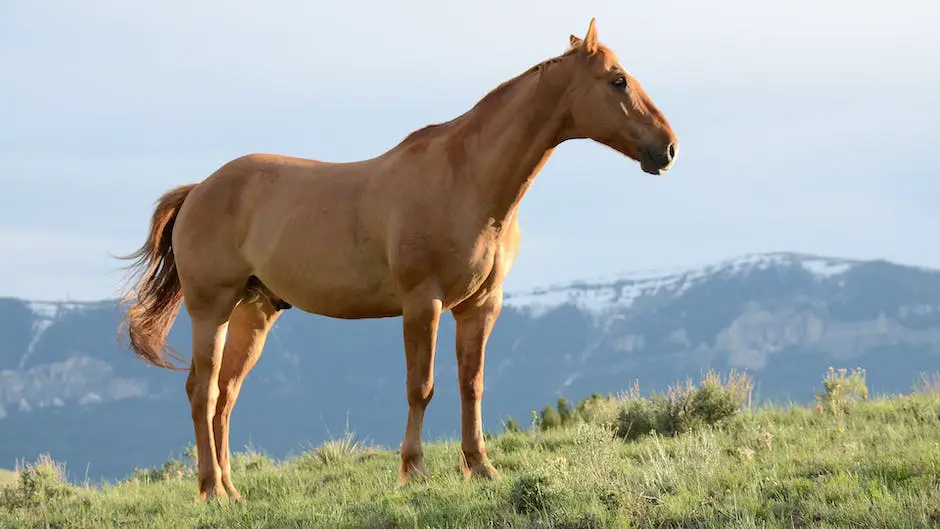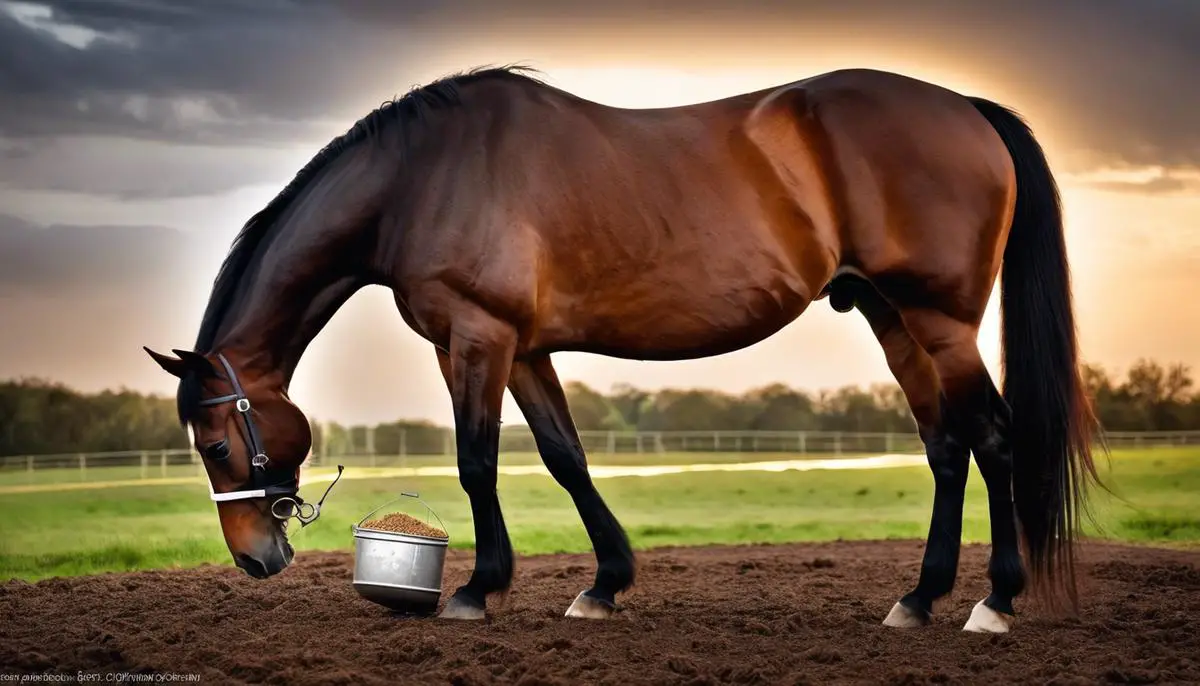Keeping Warmblood horses in top shape and securing their overall well-being requires a deep comprehension of the intricate balance between nutrition, exercise, and disease prevention. Warmbloods, known for their versatility and agility in equestrian sports, possess unique nutritional needs that directly influence their health. Also, as highly active beings, they require a specific regimen of physical activities tailored to their breed to assure overall fitness. Moreover, knowing how to identify key signs of common diseases is of paramount importance to maintain their overall health. This comprehensive understanding not only boosts their performance but, more importantly, ensures the longevity of these majestic creatures.
Table of Contents (Horspedia)
Nutrition and Warmblood Horse Health
A Well-fed Warmblood: Exploring the Link Between Proper Nutrition and Equine Health
When it comes to caring for the athletic powerhouse that is the Warmblood horse, every enthusiast knows that careful management of their diet is key. As a hobby steeped in love and dedication, understanding the intricacies of equine nutrition can drastically impact the overall health and performance of these majestic animals. Let’s dive into the world of Warmblood horse nutrition right away!
Warmbloods, renowned for dressage, show jumping, and cross-country, are demanding a lot from their bodies. In fact, their nutritional needs can be quite complex due to their significant body mass and high level of physical activity. After all, you can’t expect the best performance from your equine partner on subpar fuel!
The cornerstone of any Warmblood’s diet typically involves forage – hay or pastures. Roughage is crucial for maintaining a healthy digestive system and should constitute about 1-2% of their body weight daily. However, the nutritional content can vary based on many factors, like the type of plants, soil quality, and harvesting time, so careful selection and sourcing are crucial.
The athletic Warmblood requires a quality protein source for muscle development and recovery. High-quality protein feed like alfalfa can work wonders for their physique and strength. Experts recommend protein to constitute 10-12% of their daily rations to maintain optimal health.
However, Warmbloods are also distinguishable because they’re susceptible to equine metabolic syndrome and laminitis, conditions which can be exacerbated by too much sugar and starch in the diet. As such, their feed should have a low non-structural carbohydrate (NSC) content. Feeds like beet pulp, soy hulls, or timothy hay are excellent low-NSC choices.
Energy is another focal point in their diet, with fats proving to be a great source. Fats like rice bran or flaxseed oil are loaded with omega-3 fatty acids, which in turn promote a healthy skin and coat, reduce inflammation, and increase endurance.
Last but not least, let’s not forget about vitamins and minerals. Warmbloods require a balance of nutrients like calcium, phosphorus, magnesium, selenium, and a whole suite of vitamins. Most of these nutrients will come from a quality forage source, but a good ration balancer or multi-vitamin supplement can fill in any nutritional gaps.
Remember, a horse’s diet is not “one size fits all”, and the exact nutritional needs can vary based on age, activity level, and overall health. Working closely with a vet or equine nutritionist, it’s possible to fine-tune a Warmblood’s diet to meet their unique requirements.
The radiant glow of a healthy Warmblood boils down to the fine details of an equine nutrition plan. With time and effort, it’s more than possible to give these magnificent animals the nutrients they need to perform at their best. Because at the end of the day, a well-fed Warmblood is a happy Warmblood. And as enthusiasts, isn’t that what we all aim for? Your Warmblood’s health reflects the love and dedication poured into their care, so let’s give them a diet as excellent as the performance they provide!

Exercise and Warmblood Horse Health
The Essentiality of Physical Activity in the Health of Warmblood Horses
Warmblood horses, beloved for their strength, generosity, and versatility, are the demigods ruling the sport horse kingdom, from dressage to show-jumping. While their diet plays a pivotal role in promoting health and performance, physical activity is equally crucial. It underlines the purpose these magnificent creatures were bred for: power, endurance, and the joy of the ride.
In all equines, exercise is an integral part of their overall health and well-being, with Warmbloods being no exception. It assists in maintaining a healthy cardiorespiratory system. Regular activity stimulates an optimal heart rate, enhances lung capacity, and ensures the efficient delivery of oxygen and nutrients to muscles. It’s the perfect wellness formula for these awe-inspiring athletes.
To underscore their muscle power, physical strength, and flexibility, a gentle yet consistent exercise routine is essential for Warmbloods. Too little activity may lead to a weakness in their prestigious muscular structure, while excessive or heavy workouts can trigger harmful after-effects. Finding the golden middle in the exercise regimen maintains their vigor and majesty.
Physical activity also plays an essential role in regulating a Warmblood’s body weight. These magnificent creatures are susceptible to obesity and its incurring health problems due to their hardy and efficient metabolism. Regular exercise is a proactive approach to counteract weight-gain issues, ensuring that your Warmblood remains fit and agile, ready to seize the day!
Equally important is the role of active relaxation for these horses. Physical activity isn’t merely for their physical health, but also for their emotional well-being. Thus, providing a mix of different activities, including turnouts, riding trails, free lunging, and socializing with other equines, can be transformative. It will not only help them burn energy but also keep their minds engaged, preventing the onset of boredom or stall vices.
Lastly, involving Warmbloods in regular physical activity is akin to prepping them for an excellent performance. It fine-tunes their body, sharpens their mind, and strengthens their heart. Additionally, it improves trainer-equine bonding, establishing a line of communication, trust, and companionship.
In summary, we can confidently assert that the health of Warmblood horses isn’t merely hinged on a great feeding program. The incorporation of regular physical activity is a non-negotiable factor for them to stay in their prime shape, demonstrate standout performance, and above all, enjoy a fulfilling life. After all, a Warmblood isn’t just any horse; it’s a dynamic work of art, a symphony of strength and grace perfectly poised for motion. Thus, physical activity isn’t merely an obligation; it is an expression of their innate athleticism, allowing them to showcase their best selves.

Warmblood Horse Diseases and Prevention
Diving headfirst into the captivating world of Warmblood horses, it quickly becomes evident that a certain level of diligence is necessary to preempt potential diseases these majestic creatures are predisposed to. Warning! Adventure awaits, as we dissect some common diseases and top-tier prevention methods!
First on the docket is Osteochondrosis, a bone and cartilage developmental disease that’s prevalent among Warmbloods. It arises from an abnormal ossification during rapid growth, leading to lameness and joint swelling. But fear not, friends! This can be curbed by regulating the animal’s diet and proper exercise routines to control rapid weight and growth rates. Moreover, encouraging slower, even growth through balanced nutrition during the foal and adolescence stage can significantly minimize the occurrence of this disease.
Keep those eyes peeled for Degenerative Suspensory Ligament Desmitis (DSLD), another typical ailment that afflicts Warmbloods. Initially presenting as lameness, it degenerates into a painful condition affecting the suspensory ligaments in the legs. Hence, early detection is crucial! Frequent check-ins with the vet and consistent monitoring for any changes in gait are recommended.
On the prevention front, a well-controlled, balanced nutrition plan is vital, along with regular exercise to ensure healthy ligament status. Ethical breeding practices that consider the genetic propensity for DSLD can significantly reduce the prevalence among Warmbloods.
Warmblood horses are also prone to developing Recurrent Airway Obstruction (RAO), or “heaves.” This can initially be spotted as coughing and nasal discharge, progressing to labored breathing in severe cases. Limit exposure to dust and mold – frequent causes – by ensuring clean stables and replacing hay with pelleted feed. An appropriate ventilation system in the stables can also work wonders in preventing RAO.
Our Warmblood heroes might also face Equine Protozoal Myeloencephalitis (EPM), a neurological disease caused by a parasite. While it can be challenging to avoid as the parasite is commonly found in the environment, controlling the population of opossums – the primary carriers – can help.
Lastly, meet Warmblood Fragile Foal Syndrome (WFFS), a genetic disorder resulting in extremely fragile skin, joint laxity, and hyperextension of the joints. While this one’s inevitable if both parents carry the recessive gene, encouraging genetic testing prior to breeding can prevent the transfer.
So, the path of Warmblood horse caretaking isn’t bereft of hurdles! But with dedication, preventive measures, and timely interventions, their lives can be full of health, grace, and endless galloping majesty! Healthy Warmblood, happy horse lover!

Through understanding the interplay of nutrition, exercise, and disease prevention in Warmblood horses, we can nurture these exceptional breeds in a more informed, more engaged manner. The discussions on the suitable feeds, exercise routines, and disease prevention measures provide a more elaborate spectrum for an optimal Warmblood horse care routine. Moreover, this knowledge could be the key factor in addressing potential health problems early, preventing irreparable damage, and maintaining their prime condition. Ultimately, enriching our knowledge about their needs and the common risks they face serves as our most potent tool in enhancing the quality of life of these captivating and performance-driven equines.

